“异质同构”1926-2019年间的湖南大学校园建筑
——纪念刘敦桢与柳士英创办湖南大学建筑学科90周年
2019-10-17湖南大学建筑学院SchoolofArchitectureHunanUniversity
湖南大学建筑学院/School of Architecture, Hunan University
湖南大学的前身是创建于北宋(976 年)的岳麓书院,历经宋、元、明、清等朝代的时势变迁,一直保持着文化教育的连续性。1903 年岳麓书院改制为湖南高等学堂,1926 年定名湖南大学, 1937年成为国民政府教育部国立大学之一。千余年来,学脉延绵,弦歌不绝,故有“千年学府”之称。
“纳于大麓、藏之名山”是湖南大学校园的总体形态特征,校园西倚岳麓山,东望橘子洲及长沙城,北有凤凰山,南抵天马山,处于山水洲城之核心。校园自湘江西岸从古牌楼口到校园自卑亭,至岳麓书院及清风峡,形成一条千年的古文脉。校园沿山麓逶迤展开,与城市有机融合,形成特有的开放型校园。近年来校园内新建、改建、扩建了一批建筑,对建筑的原有功能进行了整合,各个区域之间既相互独立又相互联系,并始终保持其内在活力。各个历史时期不同风格的建筑尊重山水格局,注重尺度控制,注意对自然质感的材料与共生原则的运用,共同组成了多元化且独具特色的校园风景,“异质”却“同构”。
湖南大学校园的发展历程可以分为3 个时期。第一个时期是传统岳麓书院时期,学校主体建筑为岳麓书院建筑群。第二个时期是1926 年更名为湖南大学后,由刘敦桢、柳士英主持规划进行建设的理性开放时期,这一时期湖南大学建设了一批高质量的校园建筑,如湖大二院、科技楼、工程馆、大礼堂等。第三个时期则是改革开放后,进入了新地域校园的建构时期,近年来,学校在天马西麓征地逾13.33hm2进行新校区建设,湖南大学的总体格局基本成型。
Hunan University was originated from Yuelu Academy, established in 976 in the Northern Song Dynasty. Yuelu Academy went through the Song,Yuan, Ming and Qing dynasties and now has still held the continuity of culture and education. In 1903 Yuelu Academy was transformed and called"Hunan College of Higher Education". In 1926, the name was changed to "Hunan University", and it was listed in the ten national universities under the tutelage of the Ministry of Education of the National Government in 1937. With over thousand years of history in education, Hunan University enjoys the reputation of "Millennium university with centuries of fame".
"The famous mountain of scenic beauty,an ideal cradle-land of talents." The location of the Hunan University campus gives it unique possibilities: Yuelu Mountain sits at the west of the campus, a historical setting for discussion on succession of history; Tianma Valley at the south stretches for miles along the waterfront of Xiang River, a lively space for accommodation and resident housing; Phoenix Hill at the north side connects to an adjacent campus and provides an open access to the city, a natural symbol for the education ethos of Hunan University, and finally, the waterfront area at the east offers an open view to the hustlebustle of central city lying to the east bank of the river. Over years of redevelopment on campus, the university has kept its identity by creating a modern and open space for the education needs while at the same time having respect for the past. Planning of the campus places emphasis on landscape layout,building-scale control, natural materials utilisation,and environmental harmony. The university campus generally features pluralistic culture and picturesque scenes and as a result of redevelopment, it emerges"Heterogeneous" in the "Isomorphism" context.
There are three distinguishing building types developed along the history of the campus of Hunan University. First, academy architecture started thousand years ago and is still in the process of development. Second, modern architecture spread widely in the campus when Chinese pioneers of modern architecture, i.e. Prof. LIU Dunzhen, Prof.LIU Shiying , came the university to take charge of the campus construction after 1926. Third,new regionalism architecture becomes dominant nowadays in the modern campus. About 13.33 hm2of land has been expropriated recently and designated as the site for new development. The University campus enters a new era of development.

1 湖南大学校区鸟瞰,2019
文字/Text: 湖南大学建筑学院/School of Architecture,Hunan University
摄影/Photos: 许昊皓,胡骉,高雪雪,姚力等/XU Haohao, HU Biao, GAO Xuexue, YAO Li, etc.
图纸绘制/Drawings: 吴炳宇,赵茂繁,刘书慧,许逸伦,于思璐/WU Bingyu, ZHAO Maofan, LIU Shuhui, XU Yilun, YU Silu

2 湖南大学鸟瞰,1930

3 湖南大学建筑总平面分布图,2017
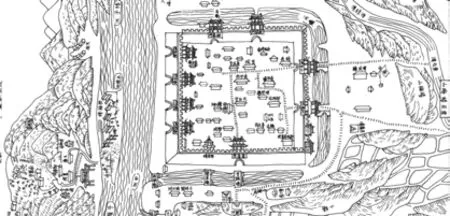
4 清长沙府疆域图,岳麓书院与长沙城隔江相望

5 岳麓山及岳麓书院的千年古文脉
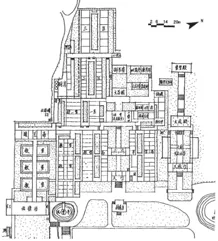
6 湖南大学1930年代校舍平面

7 岳麓书院整体鸟瞰图,1990
1 书院篇:诗意的原型
(岳麓书院时期) 976-1929
作为我国古代四大书院之一,岳麓书院前身可追溯到唐末五代(约958 年)智睿等二僧办学。北宋开宝九年(976年), 潭州太守朱洞在僧人办学的基础上,正式创立岳麓书院。嗣后,历经宋、元、明、清各代,至清末光绪二十九年(1903 年)改为湖南高等学堂,尔后相继改为湖南高等师范学校、湖南工业专门学校,1926 年正式定名为湖南大学。
岳麓书院位于岳麓山东侧名曰清风峡的山谷之中,与长沙城隔湘江而望。现存建筑大部分为明清遗物,其建筑可分为讲学、藏书、供祀、园林四部分,各部分互相连接,合为整体,是一座庭院式砖木结构建筑。书院的空间秩序蕴涵着儒家文化尊卑有序、等级有别、主次鲜明的社会伦理关系。采用中轴对称、纵深多进的院落形式,营造出一种庄严、神妙、幽远的纵深感。主体建筑如头门、大门、二门、讲堂、半学斋、教学斋、百泉轩、御书楼、湘水校经堂、 文庙等集中于中轴线上,讲堂位于中轴线之中央。斋舍、祭祀专祠等排列于两旁。整个书院建筑群完整地展现了中国古代文人建筑的儒雅气质。中国书院的选址通常避开纷繁芜杂的城市,择清静优美山野之地,更注重人与自然的协调关系和自然环境的心理教育启迪作用,其教育观与儒家理学一脉相承,“寓情于景,情景交融,寓意于物,以物比德”。
南宋乾道三年(1167 年),朱熹与张栻在岳麓书院讲堂讲学,“论中庸之义,三昼夜不能合”“道林三百众,书院一千徒”“坐不能容”“饮马池水立涸,舆止冠冕塞途”,是为当时之盛况写照。这反映了中国传统书院的开放姿态,并不与世隔绝。
在1930 年代,湖南大学校园曾经一度以书院建筑为主体,书院的传统建筑群仍然作为现代学校的校舍。这一时期的校园即岳麓书院给我们的启示包括:
(1)校园与城市虽相对分离,但其办学开放且兼容并包。
(2) 高度整合与复合化的空间。教读的讲堂与习学的斋舍、游憩空间完全整合为一体,其功能的融合性之高,往往超越现代所谓机械式功能分区的校园。这种空间的互动与相互映衬,使其使用效能优于现代简单而泾渭分明的专属空间校园布局。
(3) 适应地域气候特征。岳麓书院建筑群以基本的“庭院”单元为原型:天井相间,屋脊相连,形成连绵如蜂窝状、四通八达的整体建筑群。“行至幽厢疑抵壁,推门又见一重庭”,具有湖南传统聚落的典型特征。
(4) 书院体现了尊卑有序、伦理有别的伦理关系,并且有清晰的轴线,但亦不拘泥于轴线,其空间在局部可依循环境关系发生偏转。
(5) 书院多为一组较为庞大、严谨、 规整的建筑群,但由于重视地形的利用,多依山而建,层层叠进,错落有致,建筑虽较封闭但不框囿于形,而环境的开拓则十分开敞,两者相互映发,有机联系,收到“骨色相和,神彩互发”之效, 这为校园后来的自由发展与布局埋下了伏笔。
2004 年,在湖南大学校园岳麓书院旁建设了“中国书院博物馆”,选址于原柳士英先生设计的临时校舍“静一斋”,与岳麓书院原有的讲学、藏书、祭祀三部分,共同形成了一个完整的书院建筑群,共同表达文人建筑的儒雅气质。

8 岳麓书院斋舍内部庭院

9 岳麓书院内天井

10 中国书院博物馆外景
1 Academy architecture: A poetic building prototype: Yuelu academy, 976-1929
Yuelu Academy is one of the four ancient Chinese academies of classic learning. Its history could be traced back to a school run by two monks in the late Tang Dynasty (around 958). In 976, Yuelu Academy was officially funded by Zhu Dong, magistrate of Tanzhou prefecture. It survived the dynasty alternation of centuries, such as Song, Yuan, Ming, and Qing. In 1903 at the late of Qing Dynasty, it functioned as a school for higher learning called "Hunan Gaodeng Xuetang", and then changed to Hunan Normal College, Hunan Public Polytechnic School in succession. Finally in 1926 it took the name "Hunan Daxue (Hunan University)" that is still in use today.
Yuelu Academy is lying quietly in the valley of Breeze Cool at the east mountain foot, overlooking the city centre of Changsha to the east bank of Xiang River.Most of the existing building complex is relics of the Ming and Qing dynasties, and it basically comprises of four parts used for different purposes, such as lecturing,library, worship and leisure in the garden. Each part of the academy interconnects each other by courtyards as a whole, and it is a characteristic layout of a traditional Chinese in brick and wood.
The spatial sequence of the academy implies underlying social value and ethical relation in classic Confucian culture, which reflects a strict hierarchy system of a class society and concepts of superiority and inferiority. The building complex is symmetrically arranged in general and the buildings of significance including the Main Gate, the First Gate, the Second Gate, the auditorium, study hall, lecture theatre, Baiquan Pavilion, Yushu Library, Xiang Research Institute and Confucian Temple are positioned in order along the central axis. Other buildings for accommodation, worship etc. are built away from the central line according to the zoning strategies of the academy. The overall building plan reveals principles of Chinese traditional architecture: building siting has regard to the environment inhabitability("Fengshui") upon which a harmony relationship between man and nature could be built, and the favourable built environment may be therefore created to inspire users both physically and psychologically. Chinese educational architecture has the same principles and follows the motto of Confucian: "being sympathetic to nature for open-mind,being thoughtful to matter for self-integrity."
In 1167, Confucian master ZHU Xi and ZHANG Shi gave open lectures in the auditorium of the Yuelu Academy.They presented views on different Confucian schools and debated openly on hot topics in Confucian. There was a record turnout of over thousands attendees for such an event of that time. It is a typical portrait of open education mode in the traditional Chinese Academy buildings.
Yuelu Academy was once dominant in the university campus and then functions as a part of educational infrastructure in the campus of the modern age. Yuelu Academy of this period suggests that it has the following valuable architectural aspects in light of campus development:
(1) Academy was though located in a remote region from city, but its education system pursued openness and excellence at the same time.
(2) Spatial arrangement of academy was highly integrative and compact. One building complex could facilitate purposes of teaching, study, research and recreation. The space organisation appears particularly efficient and is better than the functional zoning in modern buildings.
(3) Building layout responded to bio-climate of the region. Courtyard is the building prototype of the academy, which is advantageous to create the favourable environment inside as well as to allow buildings to interconnect each other at any direction according to space requirement. Its overall configuration turns out "passage seems never to end as one courtyard after another".
(4) Educational architecture follows classic principles of spatial order, but it is also pragmatic and seems to put function at the first place when the surroundings are not flexible.
(5) Academy architecture is a large scale of building complex. Its site is carefully selected and its buildingform reflects the surrounding conditions. The focus of attention is generally given to hold a balance and harmony relation between man and nature. This set up a basic law for later campus development that is "to harmonise with surroundings, to synergise for mutual benefits".

11 湖南大学重要校园建筑时序图

12 刘敦桢

13 柳士英

14 柳士英规划的湖南大学校园同心圆
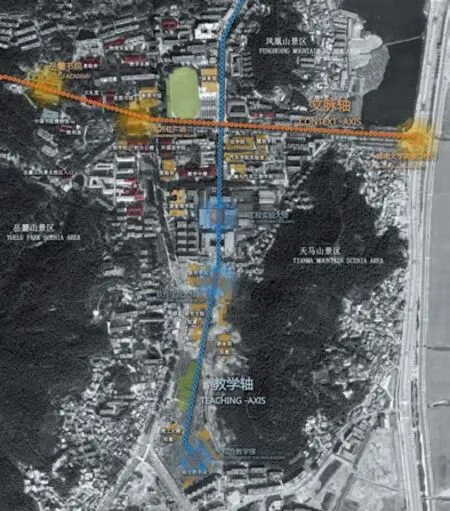
15 湖南大学的文脉轴和教学轴

岳麓书院建筑与文化
作者:杨慎初
出版:湖南科学技术出版社,2003

营造
Construct
作者:魏春雨
出版:中国建筑工业出版社,2005

异质同构:从岳麓书院到湖南大学
Heterogeneous Isomorpism
作者:魏春雨,宋明星
出版:中国建筑工业出版社,2013

中国近代建筑纲要(1840-1949)
Outline of Chinese Architecture of Modern Times
作者:黄元炤
出版:中国建筑工业出版社,
2015

柳士英 中国近代建筑师系列
作者:黄元炤
出版:中国建筑工业出版社,2015

论湖湘建筑的思与辩/湖湘当代建筑师:二十四人侧访
24 Huxiang Architects/Thoughts on Contemporary Huxiang Architecture
作者:王蔚 等
出版:中国建筑工业出版社,
2019
2 先贤篇: 理性的开放
(早期湖南大学建立时期)1929-1953
刘敦桢与柳士英为开创湖南大学建筑学科的两位先贤。1929 年,刘敦桢在湖南大学土木系中创立建筑组,是为湖南大学建筑学科的开端。随后刘敦桢应邀去北京参加中国营造学社的工作,邀请其留日师兄柳士英来湖南。柳士英1934 年来到湖南大学,继续发展建筑学教育, 聘请了蔡泽奉、许推等一批留日、留欧美的学者担任教授,此时有建筑学专业教师10 余人,成为一支强大的建筑学专业队伍。1953 年院系调整,湖南大学、中山大学、南昌大学、广西大学、武汉大学、云南大学、四川大学的土建与道路、铁建各专业合并,成立中南土木建筑学院, 成为中南地区实力最强的土木类的学院,柳士英任院长。从刘敦桢、柳士英、蔡泽奉等人在1920- 1940 年代设计校园建筑开始,到之后杨慎初、黄善言对岳麓书院的修复,直至今日的教学建筑、校园环境设计,湖南大学建筑学院始终进行着对湖南大学校园的设计、改造、保护工作。柳士英先生在湖南大学一直从事教学与设计工作直至1973年逝世,他不仅制定了这一时期湖南大学的校园规划,也在这里留下了大量经典的校园建筑作品。因此,湖南大学的校园被深深地打上了柳氏的烙印。
岳麓书院自建立之初就形成了一条明显的中轴线,它自上而下经自卑亭、牌楼口、一直延伸到湘江边。这是规划中非常重要的一条轴线,但柳士英力图避开这条轴线,以理性、开放的思想建构理想中的新型校园,与此同时,对旧的文脉与形式保持了最大的尊重。他根据校园的地形地貌特征提出4 个同心圆的规划理念,核心的圆为体育活动区,第二个圆为教学区,第三个圆为学生活动区,第四个圆圈为教职工生活区。最外层为岳麓山景区。体育区在最中心方便师生集合,教职工生活区接近公园景区, 成为师生课余休憩之地。日常教学、教职工、学生3 个区之间相互融合,联系便捷。而美丽的岳麓山环绕校园四周,形成了以广场、运动场、 绿地、大型公共教学楼为主的开放型校园。
湖南大学在中国的大学校园中具有非同一般的独特性,那就是她的“开放性”。一直以来, 湖大没有围墙,甚至没有校门,市政道路、公共交通及岳麓山的游客穿行相间。在这样的校园中, 校内与校外、社会与大学的区别被模糊了,古与今的界限也被模糊了。
这一时期的校园与建筑变化给我们的启示是:
(1)隐形的轴线。由于柳士英的规划,岳麓书院原有的强烈的轴线感被消解了,校园的结构更加自由,形成同心圆式的分散式布局,在校园的规划中体现了现代大学的自由精神。
(2)形成了“异质同构”的校园特色。这一时期建成的校园建筑不拘泥于传统形式,大胆创新,取各家之长,在校园内中国与西洋、传统与现代、大学与城市之间,形成了共生与融合的氛围。
这是校园的第一次传承与“变异”,是一次异质同构的过程。自此确立了兼容并包的开放型校园特质。
2 Influential Predecessors of modern campus architecture (Hunan University): Rationalism and Openness, 1929-1953
There were two important figures in the history of architectural education in Hunan University: Prof.LIU Dunzhen and Prof. LIU Shiying. In 1929 Prof. LIU Dunzhen initiated an architectural research group within the Department of Civil Engineering, which marked the beginning for architectural disciplinary development.Then he invited his alumnus Prof. LIU Shiying to join him in the university when he went to Beijing for the work of the Society for the Study of Chinese Architecture (SSCA).Since Prof. LIU Shiying came to Hunan University, more scholars with overseas study background had taken lecturing positions in the university. A team of over 10 architectural professionals gradually took shape. In 1953, the departments of civil engineering in several key universities, such as Hunan University, Sun Yat-sen University, Nanchang University, Guangxi University,Wuhan University, Yunnan University, and Sichuan University, merged together and founded a School of Civil Engineering of the Middle South of China under the leadership of Prof. LIU Shiying. Construction work on the university campus was initiated by Prof. LIU Dunzhen,Prof. LIU Shiying and Prof. CAI Zefeng in the 1920s to the 1940s, respectively. Following the restoration of Yuelu Academy led by Prof. YANG Shenchu and Prof. HUANG Shanyan, School of Architecture in the Hunan University has carried out work regarding planning, environment strategies, campus redevelopment and building renewal in the university campus ever since. Prof. LIU Shiying had engaged very work of architecture education and design in the campus until his death in 1973. A great number of architectural works he had done remains in the campus and become precious living memories of the history of this period.
The campus has a clear central axis starting from the academy, passing through Humble Pavilion and down to the waterfront of Xiang River. It was a reference line to guide the campus planning. However with respect to the tradition culture and exiting terrain situation, Prof.LIU Shiying proposed a new plan of the campus upon the axial mode: four concentric rings concept. The central area of the rings was designated to sport events. The area of the second ring facilitated space requirement for education, meanwhile the student accommodation and residential sector for staff located in the third and fourth ring respectively. At the outmost area was the resort of Yuelu Mountain located close to the staff living district.This plan allows different districts of the campus to be independent but they are also connected efficiently when needed. Consequently an open campus took its form with a square, playgrounds, green-base and relative bulky educational buildings in the central area.
Hunan University features unique "openness" in the education system and campus organisation. Until now, the university campus pride herself on holding an open attitude both to the public and the city. The campus interweaves the fabric of the Changsha city, hereby the boundary between the "inside" and "outside", the campus and community, eventually the past and present is unidentifiable.
The university campus of this period had notable characteristics as below:
(1) Resilient structure of the campus. There were two basic modes of planning interrelating with one another so that a free and open campus has been created. The present university campus could be an epitome of modern university of free spirit.
(2) Campus architecture of heterogeneous isomorphism. Having respect for historical buildings,the predecessors of modern architecture in this period took innovative concepts of modern architecture and technologies with ambition to build a unique university campus for the locals.
To sum, the campus of Hunan University had established her uniqueness in openness and integration after its first transformation.

16 湖南大学校园建筑
二院/The Second Teaching and Research Centre
建筑师/Architect: 刘敦桢/LIU Dunzhen
建筑面积/Built Area: 2929.6m2
占地面积/Site Area: 1464.8m2
建设年代/Construction Time: 1925
湖南大学二院是中国早期著名建筑师刘敦桢先生少数的建成建筑作品之一,并且是刘敦桢先生刚开始从事建筑设计时的作品。刘先生一直从事大量的理论研究,几乎没有留下几栋建筑作品。因此,这栋建筑的价值不仅在于其富有个性的设计, 更多的是它的历史和学术价值。二院原为教学楼,有西洋式屋顶,平面呈“山”字形,门窗形式统一,富有特点;砖的砌法考究,并有多种预制砖。
The Second Teaching and Research Centre is one of a few completed architectural work done by Prof. LIU Dunzhen, who was an early renowned architect in China,and it was a result of work at the early stage of his career.Prof. LIU Dunzhen had been engaging the theoretical studies immensely, and hence only a limited number of buildings have been left to us. This building is of historical and academic value owing to its uniqueness in design.


17 二院
科学馆/The Building of Science and Technology
建筑师/Architects: 蔡泽奉,柳士英/CAI Zefeng, LIU Shiying
建筑面积/Built Area: 4353m2
建设年代/Construction Period: 1933-1937
加建时间/Building Extension Time: 1948
最先由当时土木系的蔡泽奉教授设计,1933 年开始兴建,到1935 年建成。砖混结构、西洋古典风格,檐口、拱券形大门等处均为典型的古典复兴样式,具有完美的比例,均衡的体量,细腻的大样还有相得益彰的阴影效果。1948 年由柳士英主持加建了一层,保留了原有塔楼和女儿墙及檐口,将原有的平屋顶找平作为第三层楼板,而后加上了琉璃瓦的西洋式坡屋顶。很好地延续了原有建筑的风格和气质,浑然一体,成为柳士英一大杰作。
This building was initially two storeys designed by Prof. CAI Zenfeng from the Department of Civil Engineering and completed in 1935 at first. It is brickreinforced concrete structure built in the classic western style as the building details, for instance, cornice, archery door and so on, were typical style of classic renaissance.The scale of building is in a perfect proportion and its appropriate space volume helps to create delicate light shades. In 1904, an extension had been made by Prof. LIU Shiying to add one more storey on top of the old building.



18 科学馆
七舍/The 7th Student Hall
建筑师/Architect: 柳士英/LIU Shiying
功能/Function: 学生宿舍/Student dormitory
建筑面积/Built Area: 2511m2
占地面积/Site Area: 979.7m2
竣工时间/Complete Time: 1951
七舍最大的特征是南立面那极富表现主义色彩的牌楼。曲线的母题贯穿整个牌楼,从底层拱门及上方的曲面浮雕,到上部并列的3 个圆窗,再以圆弧封顶。中部则用竖向长窗贯通,在提供楼梯间大面积采光的同时成为立面简洁的构图元素。七舍“7”字的八角形底板也与拱门左右两个八角形窗形成呼应。七舍南立面上也运用了与工程馆相似的手法,将窗间墙塑造成三角形截面以形成阴影,由于窗下墙使用了与清水砖墙不同的材质,突出的窗间墙形成了竖向的完整线条,凸显了分离派的特点。
The distinguishing features of the 7th Student Hall are the curvature motifs which appear throughout this building, such as the three fenestra rotundas on the top middle of the southern elevation, an archery way on its main entrance, and the elegant curve reliefs on the wall. The varied designs of octagon adorn the south side of the building. The piers between the windows were devised in a triangular section so that a delicate lightshade effect could be created. The effect has then been enhanced by the external cement plaster on the breast under the windows in contrast to Shimizu bricks on the otherwise wall area. In all, the elevation design of the 7th Student Hall Seven attains a flavour of Expressionism and Secessionism in architectural details.


19 七舍
教学北楼(工程馆)/North Building for Education(Building for the Department of Engineering)
建筑师/Architect: 柳士英/LIU Shiying
建筑面积/Built Area: 7430m2
占地面积/Site Area: 2060m2
设计时间/Design Time: 1947
竣工时间/Complete Time: 1953
湖南大学工程馆(现为教学北楼)是柳士英先生现代主义风格最典型的代表作。一方面,建筑为砌体建构,表面部分涂刷素混凝土;另一方面,未用任何细小装饰,把细小线条变成了面的延续。平屋顶高低错落。建筑楼梯间的圆弧形墙体,墙面上通长的水平线条,以及圆弧形窗檐,窗台和窗口墙体, 都具有典型的德国表现主义流动线条的造型特征。而各种曲线面处理的承前启后,有起有落,体现了他将这些独立的元素通通揉进建筑肌体之中的设计方式,人称“柳式圆”。
The North Building could exemplify the design style of Prof. LIU Shiying in his career as a modern architect. Two leading schools of modern design, Vienna Secessionism and German Expressionism, influenced the thinking and aesthetics of architectural design of Prof. LIU when he was in his academic pursuit of architecture in Japan. On the one hand, the staircase is screened inside a curve wall,and windows were designed with round lintel, curved sills and breasts underneath. These building designs reflect the influence of German Expressionism featuring flowing lines,but are imprinted with his own style of "Dynamic in static"as a flowing line is completed with a circle, which is the treatment thereafter given a name "LIU's Circle".


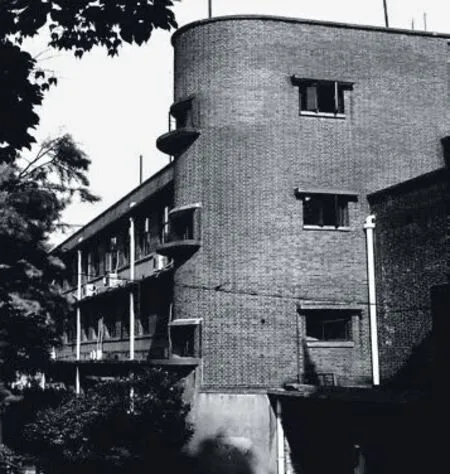
20 教学北楼(工程馆)
湖南大学大礼堂/The Grand Hall of Hunan University
建筑师/Architect: 柳士英/LIU Shiying
建筑面积/Built Area: 2142m2
占地面积/Site Area: 1094m2
设计时间/Design Time: 1951
竣工时间/Complete Time: 1953


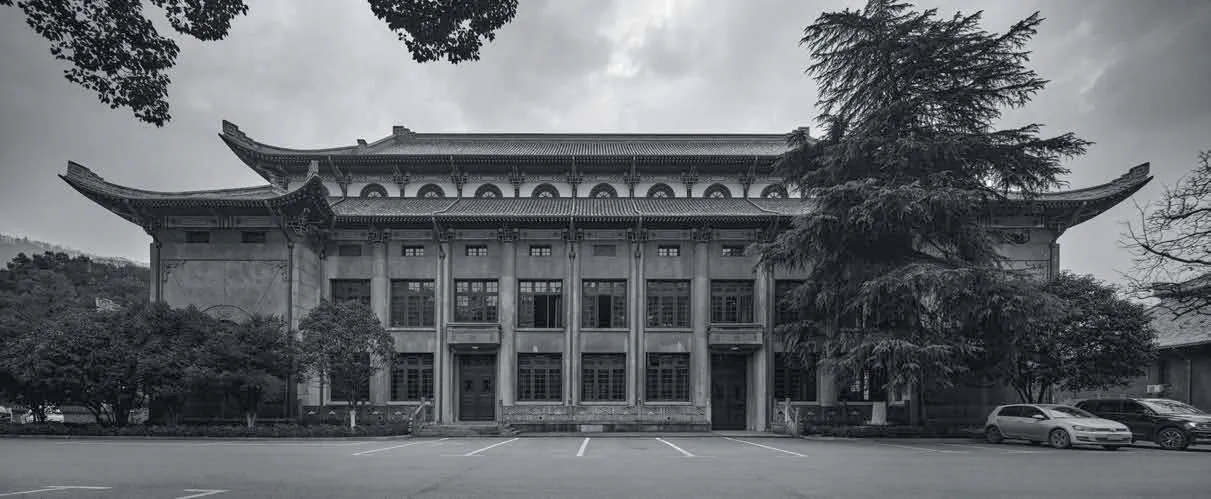


21 大礼堂
大礼堂采用官式绿色琉璃大屋顶,但又不拘泥于法式做法,力求淡雅、明快,礼堂装修采用国漆红黑色主调,点缀金饰,既保存了湖南楚汉文物的艺术特色,又颇具现代意味。外墙粉刷以普通水泥掺和黄泥石灰碎玻璃等,达到了经久耐用的目的和较好的彩色效果。
The interior decoration is a mix of modern design and traditional Chinese fine art of Xiang, which dated back to Han dynasty 2000 years ago. Chinese lacquer paint is dominant with a garnish of golden design. A mixture of cement, yellow limestone and glass cullet had been used on the exterior wall, and hereby a long last colour shade of external wall had been achieved.
图书馆/The Library
建筑师/Architect: 柳士英/LIU Shiying
建筑面积/Built Area: 2362m2
占地面积/Site Area: 1097m2
设计时间/Design Time: 1946
竣工时间/Complete Time: 1948
扩建设计时间/Extension Start Time: 1951
扩建竣工时间/Extension Complete Time: 1954


22 图书馆
图书馆所处位置较为特别。沿岳麓山清风峡而下,经岳麓书院,这里是被读书人称为“风水宝地” 的地方,形成了湖南大学建筑的第一条中轴线。在这根中轴线上,建有3 座图书馆:岳麓书院御书楼、老图书馆和现在的图书馆。由建筑大师柳士英设计建造的老图书馆,1948 年竣工,有书库3 层,目录厅和办公房若干。碧瓦红砖,飞檐画栋,形式古朴。1947 年馆藏图书79,182 册。该馆曾于1951 年扩建,总面积超过2300m2。她与岳麓书院前的大礼堂组成了极富民族特色的仿古建筑群,成为湖大校园建筑的“经典”。
This old library is located on the central axis of the university campus, like other two libraries in the campus.The old library was designed by Prof. LIU Shiying and completed in 1948. It had three-storeyed storage rooms for books, one category and load service hall, as well as a few offices. In 1947, the book storage was up to 79,182 copies and a building extension had been made in 1951 so that the overall floor area had reached 2300m2.
3 营造篇:新地域的建构
(现代湖南大学发展时期)1954-现在
1960-1980 年代,学校的建筑量并不大,这一时期建成的有化工楼、电气楼、中楼、东楼等一批较朴实的校园建筑。然而自1980 年代起,由于学校迅速的发展,校园面积不断扩大,故而在原有校园中心区的基础上进行了大幅 的改造、扩建及新建。这是校园的第二次传承与变异 , 书院仍然是湖南大学的文化中心,校园的文脉与特色得以保留。我们选择将原有中心区南移, 在天马山西麓新征用地进行教学建设,将校园的发展引向南面。于是形成了相互垂直的两条轴线:一条为文脉轴,起始于岳麓书院,垂直于岳麓山,收于湘江畔牌楼口,所谓“藏之名山”;另一条为新的轴线,我们称之为教学轴,平行于岳麓山,新老校区通过轴线结合,该轴线在运动场处进行了扭转,形成一个完整而又富于变化的空间序列,所谓“纳于大麓”。
从总的校园发展历程来看,可以发现其中交融着几种关系,主导了校园空间形态的变迁:
(1)校园与城的关系:书院选址与城市相对脱离,须经牌楼口摆渡登岸方可进入学府修身求学之地。而现代大学则在形态上与城市气息相吻合,较为现代。
(2)校园与山的关系:岳麓书院最早兴起于宋朝佛僧兴办佛堂,并一直延续到元、明、清,其主要建筑藏于山林峡谷。而现代校园规划中,岳麓山更多的是做为一个大的屏障,学校的建筑逐渐与山脱离,尽量不把活动导入山间。
(3)新与旧的关系:早期岳麓书院是自然生长的发展模式,如岳麓书院的斋舍,顺应山势以及地形自然生长。而近20 年的发展,校园内新建了一大批现代建筑,在建筑形体、材料及尺度上更多是顺应场地,而且没有完全克隆传统的材料与风格,在总体校园环境中形成了风格相对明显的区域,但因时因地的新地域手法使岳麓书院的文脉与空间形态得以延续。
3 New campus architecture (Hunan University):Regionalism and construction, 1954-present
In 1960s-1980s, there were only a number of purpose-built educational buildings, such as Building of the Department of Chemistry, Building of the Department of Electrical engineering, Central Building for Education, East Building for Education, etc. They were built in the architectural style of modernism emphasising on minimalism and functionalism. Since the 1980s, the university campus expanded quickly and has experienced a large scale of redevelopment upon its historical central area.
In the overall course of the campus development,it is found that the dominant relations exerting considerable influence on the spatial transformation of the campus can be identified as below:
(1) Spatial relation between the campus and the city. With the changes over the years, the campus has interwoven with the urban fabric intensively, and is not the same as it used to be.
(2) Positional relation between the campus and the Yuelu Mountain. The Yuelu Mountain nowadays functions as a natural protective screen overlooking the campus rather than a part of redevelopment site for campus architecture as before.
(3) Historical relation between the campus architecture of the past and the present. The new campus architecture has created its own identity from the angle of regionalism, managed to integrate the different styles of architecture in vary construction approaches which are responsive to the surroundings and the times, and kept striving to achieve sustainability of the campus development.
During the second period of transformation in the campus, the position of Yuelu Academy as a culture centre remains intact. Apart from the old central axis of planning as a reference to "hold historical campus of scenic beauty", a new axial line has developed in the campus that intersects the old one at a right angel.The new one parallel to the Yuelu Mountain range and suggests a new planning strategies for "creating a modern cradle land of great talents", notably for the educational development on the campus.
法学院、建筑学院建筑群/The Building Complex for the School of Law and the School of Architecture
建筑设计/Architects: 魏春雨,宋明星,李煦,齐靖/WEI Chunyu, SONG Mingxing, LI Xu, QI Jing
建筑面积/Built Area: 10,784m2(法学院/School of Law), 5000m2(建筑学院/School of Architecture)
设计时间/Design Time: 2002(法学院/School of Law),2003(建筑学院/School of Architecture)
竣工时间/Complete Time: 2003(法学院/School of Law), 2004(建筑学院/School of Architecture)


23 法学院、建筑学院建筑群
法学院、建筑学院建筑群体现了“场域”意识,让“建筑从土里生长出来”。在自身限定的区域中,设计从场地到建筑统一采用水刷石饰面,对光形成漫反射,使建筑“折旧”而易于融入周遭。结合坡地地形设置的舒缓台阶踏步,在逐级上升过程中自然渐变为建筑本体,完成一个共同的“场域”。尝试用湘江中的石子作为原料,通过水刷石这种传统工艺做成外墙。把石子墙面延伸到室内,水刷石对光具有漫反射和折射效果,在不同季节、天气和阳光角度下可以呈现不同的色泽和明暗感觉。
The building complex for the School of Law and School of Architecture seeks for the architectural succession of tradition and integration in the campus. The design principles of Regionalism have been displayed when designing this complex. Granitic plaster, a local sourcing of building materials from nearby Xiang River, has been applied in a large quantity on the interior/exterior walls of the building in order to create a material identity of the place. Terraces gently run down along the building's north and west wings. A building responsive to the site where it is embedded and therefore takes its shape.
综合教学楼/Multi-purpose Building

24 综合教学楼西北角透视
建筑设计/Architects: 魏春雨,李煦/WEI Chunyu, LI Xu
建筑面积/Built Area: 20,997m2
设计时间/Design Time: 2008
竣工时间/Complete Time: 2010
理工大楼建筑群/Science and Engineering Building Complex

25 理工大楼大楼梯
主持建筑师/Principal Architects: 魏春雨,宋明星/WEI Chunyu, SONG Mingxing
建筑设计/Architects: 李煦,张光,沈昕,欧阳素淑,李雅侠,熊丹丹,张文雅/LI Xu, ZHANG Guang, SHEN Xin,OUYANG Sushu, LI Yaxia, XIONG Dandan, ZHANG Wenya建筑面积/Built Area: 10,378.5m2(A栋/A),6739m2(B栋/B),7323m2(C栋/C)
设计时间/Design Time: 2012
竣工时间/Complete Time: 2016
中国书院博物馆/China Academy Museum

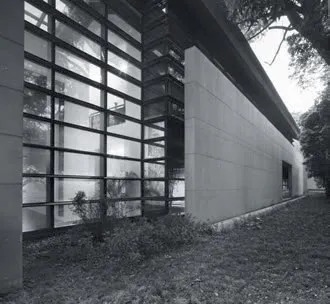
26 书院博物馆
主持建筑师/Principal Architect: 魏春雨/WEI Chunyu
建筑设计/Architects: 齐靖,胡晓军,梁宝燕,凌钰翔,马迪,王雨前/QI Jing, HU Xiaojun, LIANG Baoyan, LING Yuxiang, MA Di, WANG Yuqian建筑面积/Built Area: 4736m2
设计时间/Design Time: 2004-2007
竣工时间/Complete Time: 2012
工商管理学院/Building of the Business School
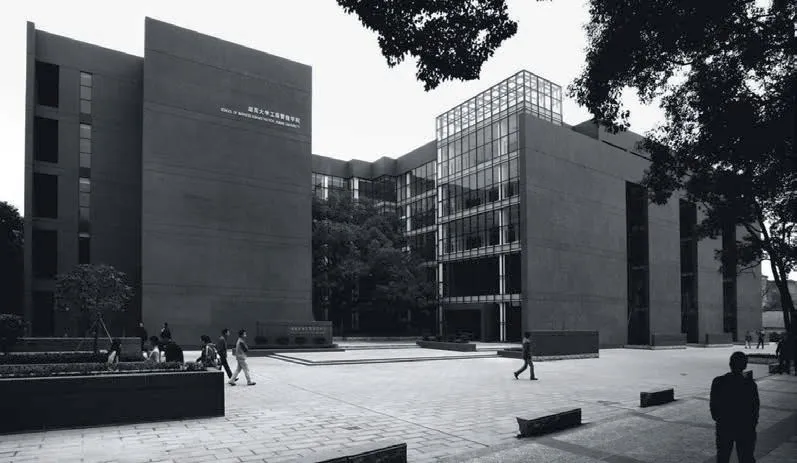
27 工商管理学院西面透视
建筑设计/Architects: 魏春雨,宋明星,李煦,齐靖/WEI Chunyu, SONG Mingxing, LI Xu, QI Jing
建筑面积/Built Area: 16,291m2
设计时间/Design Period: 2003-2004
竣工时间/Complete Time: 2006
游泳馆/Aquatic Centre
主持建筑师/Principal Architects: 魏春雨,黄斌/WEI Chunyu, HUANG Bin
建筑设计/Architects: 顾紫薇,彭军,吕昌,周瑞,蒋康宁/GU Ziwei, PENG Jun, LYU Chang, ZHOU Rui, JIANG Kangning
建筑面积/Built Area: 6900m2
设计时间/Design Time: 2010
竣工时间/Complete Time: 2016
研究生院楼/Graduate School
主持建筑师/Principal Architects: 魏春雨,李煦/WEI Chunyu, LI Xu
建筑设计/Architects: 伍帅,刘海力,陈天意,覃丽伊,卢晶,刘镜淇,付超云,王记成/WU Shuai, LIU Haili,CHEN Tianyi, QIN Liyi, LU Jing, LIU Jingqi, FU Chaoyun,WANG Jicheng
建筑面积/Built Area: 29,012m2
设计时间/Design Time: 2011
竣工时间/Complete Time: 2016



29 研究生院楼
